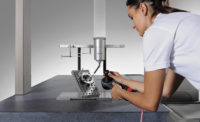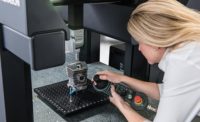Smart organizations are taking a holistic view of their manufacturing operation and a hard look at their inspection and quality practices. As technology has progressed, so has the manufacturer’s ability to closely align their unique needs and applications to the selection of a coordinate measurement machine (CMM). There are three primary considerations to help guide the decision-making process for a next generation CMM based on application need: throughput, precision and shop floor capability. The selection process involves various levels of precision, flexibility, and speed—to best suit each application.
Throughput
As production demands increase, manufacturers are compelled to find a more efficient measurement solution. A current example is the aerospace industry where backlogs have risen to new heights with a decade’s worth of orders currently scheduled. Measurement operations have become a bottleneck for this sector, prompting the move toward new and improved solutions.
Sensor selection can be key, options from touch probe to analog scanning to noncontact point and line sensors provide the flexibility to optimize measurement cycle times. Tool changing racks allow operators to program sensor changes throughout the measurement routine, providing more flexibility to tackle other tasks without having to interfere during a measurement routine. Scanning sensors are rapidly replacing touch probes, as they both improve throughput as well as measured data density.
Additionally, the introduction of offline programming for CMMs has proven to be an effective strategy for improving throughput. Programmers can develop inspection routines for new parts or improve existing routines without interfering with production. The ability to share and store inspection programs minimizes programming bottlenecks that can impact overall production. Moreover, CMM manufacturers also provide contract programming services to support customers when their CMMs are at full capacity.
Precision
The precision requirements needed to maintain competitiveness are more intense than ever before. Tighter tolerances requiring more accurate measurements continue to be key drivers of new product development for CMMs, as they need to be faster and extremely accurate. CMM manufacturers had to make great strides in order to meet these often conflicting design objectives and provide maximum value in the metrology products delivered to their customers, these next generation systems called for innovative design changes, intelligent material choices, and novel manufacturing techniques. The end goal being an affordable machine that is highly accurate, measures parts quickly, and is relatively insensitive to environmental conditions.
There are three factors to mull over when the goal is to improve CMM precision. First, take a look at the materials used in the design of the CMM. Lightweight components in the traveling part of the structure reduce the forces necessary to accelerate them during machine motion. These elements facilitate the use of less powerful and cooler running motors, while at the same time causing less frame distortion due to inertia. Aluminum is the ideal material for these components. With the proper extrusion process, the material enables manufacturing of large structural elements with the greatest impact on stiffness. Aluminum also has specific thermal properties that make it more viable for CMM designs.
The type of styli used with a CMM can also have a major impact on the precision of the machine. Maximum stiffness of the stylus and geometric accuracy of the stylus tip are vital to measurement accuracy. Meticulous design and stringent process control deliver styli with maximum rigidity, strong integrity of the bonding of the probe ball to the stem, and proper sphericity of tips. CMM performance and inspection results can be easily compromised if a stylus has inconsistent ball roundness, poor ball location, bad thread fit or an inferior design that allows excessive bending during measurement.
The introduction of software-based measurement compensation has proven to be beneficial in addressing predictable errors within measurements. This approach is based on the premise of understanding and mathematically characterizing a CMM’s predictable measurement error sources, therefore the CMM controller software can automatically correct the measurements. Over time, these compensation techniques have grown increasingly more sophisticated, encompassing both static geometric errors and all sorts of dynamic and thermally induced geometry errors.
Bringing Inspection to the Shop Floor
Another selection factor is the location and footprint available for a coordinate measuring machine in the facility. Today’s trend is to make the measurement operation closer or incorporated into the production operation. If the luxury of a temperature controlled metrology lab is not present, or there is limited space in the plant, a shop floor solution might be a smart choice. A shop floor CMM is also the right way to go if there is a need to increase an inline inspection process with a system that can survive the demands of the production area.
Generally speaking, shop floors are subject to higher vibration forces, have limited available space for equipment, and air quality is oftentimes less than perfect. To help solve some of these problems, CMM manufacturers have produced new designs to fit seamlessly on a shop floor with smaller footprints. Protective options (bellows, enclosures) shield CMMs from environmental contaminants, and the addition of hard bearing scales has eliminated the need for shop air.
Additionally, the combination of temperature compensation and vibration dampening gives shop floor CMMs the flexibility to inspect anywhere in the manufacturing line. Today, CMM manufacturers are also focused on improving the user experience during the measurement process. One example is the addition of message lighting and text alerts above the workspace, which gives operators both better visibility of the measurement status, freeing them to focus on other tasks.
Application Specific
As manufacturers take on new projects, custom solutions may be the answer to their challenges. Whether it is a niche product or an assembly of complex parts, CMM manufacturers with large product portfolios are packaging solutions that meet their customer’s application specific measurement needs.
CMM manufacturers are shifting their focus to providing applications on project based solutions. Starting with measurement routine development services, including programming, work holding solutions and system deployment. Automation is a driving trend where CMMs are being equipped with automated work handling systems, to fully integrated in-line measurement stations. Application needs continue to evolve and CMM manufacturers are working hard to keep pace with the rapid change.
The End Game
Modern CMM engineering presents tradeoffs involving accuracy, throughput, and environmental flexibility to name a few of the most important parameters. By making intelligent design decisions involving the selection and application of the appropriate materials, and taking full advantage of software error compensation, today’s CMM designer can balance CMM design parameters to provide real-world metrology solutions.
The overall CMM selection process can seem like an overwhelming task, but it does not have to be. Gaining an understanding of the various CMM characteristics and manufacturing business needs of a company can provide a strategic roadmap to choose the right machine for a specific application. As with all capital purchases, balancing the benefits and tradeoffs of each individual design is a critical part of system evaluation.




